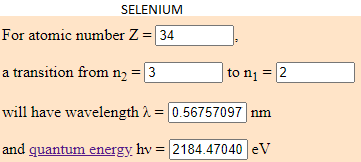The Pacman Nebula (NGC 281) is a cosmic cloud of space gas. This nebula gets its name from the classic video game character it resembles. Many people think that this nebula resembles a heart when viewed at the right angle.
NGC 281 is a rather diffuse red-glowing emission nebula. It includes a small, yet noticeable open star cluster (IC 1590) and dynamic dust lanes. The prominent lane of dark dust cutting into this glowing nebula creates the “mouth” of this nebulas shape.
This is its energy spectrum from JS9 with its most importants energy peaks.

Then, I have calculated each peak's percentatge and find out which elements they contain.
I have used this formula:
 |
|
Here are my results:
 |
|
This nebula has:
- 5,6% of Vanadium (V) which energy is 999.6408 eV.
- 5,3% of Nickel (Ni) which energy is 1481.5093 eV.
- 6,2% of Galium (Ga) which energy is 1815.9827 eV.
- 5,2% of Selenium (Se) which energy is 2184.4704 eV.
- 7,6% of Europium (Eu) which energy is 7500.1410 eV.
COMPARISON
I have search for scientific articles that explain which chemical elements are in NGC 281. Although I have not find any that say the element it has, I have deduced that, according to CO and H2O obsertvations of the H II region NGC 281 by Bruce G. Elmegreen (1977), the nebula contains a big percentage of carbon, oxigen and hydrogen.
In comparison with my results, they does not match with the article.
- Based on my investigation, this nebula is form of vanadium, nickel, galium, selenium, and europium.
- What I have done is to find the eV of the tallest peaks of the JS9 energy spectrum and discover what element corresponds to that enery.
|
|
 |
 |
|
|
|
I have calculated the electronvolt of this elements with the transition predetermined in this web (from the cap 3 to the 2). The atoms to jump from this capes have to be in a room temperature. Depending to the temperature, the element can have different quantum energy. What is the same, a eV number can be from different elements if they are moving arround differents capes.
It can be possible that the atoms are not moving from the capes I have work with and this might be the reason why my results does not match with the scientifics results.


